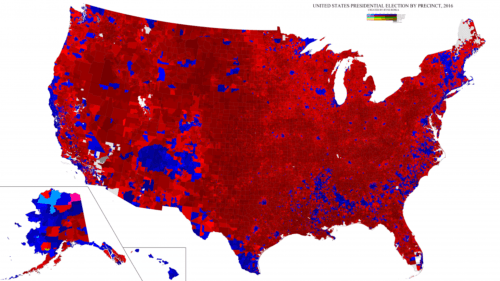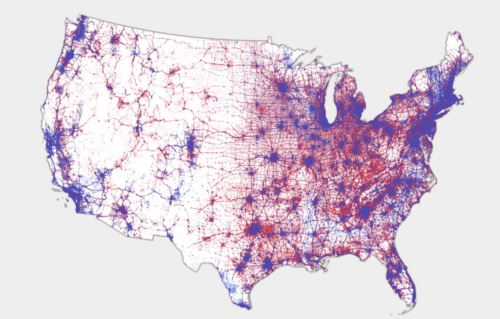Some conservatives use the phrase ‘real America’ to pick out some kind of mythical utopia of their liking. The concept itself is hardly new. In fact, it sits uncomfortably close to various fascist myths about ‘blood and soil’. But in this contemporary version of the myth, salt of the earth, conservative types supposedly suffer under the repression of the liberal, multicultural elite.
And, of course, with this myth of ‘Real America’ comes the pushback. Consider, for example, shows like Real America with Jorge Ramos, a show that fights back against the myth while, arguably, leaning in to the frame.
Land
To some extent, ‘real America’ is a myth about land. That’s the first part of it, anyway. Conservative pundits never tire of showing those graphics about how much US soil votes for Republican candidates. Here’s the precinct-level data from the 2016 election:

Source: NBC News
The idea here is that conservative politics dominate large swaths of US soil, and therefore there’s a conservatism undergirding US society. And yet there’s a big problem here: US soil doesn’t vote! People vote! What if, rather than coloring land, we made a dot for each person who voted? What would that map look like?
That’s the idea behind using pointillism in our map-making. And the map looks like this:

Source: Wired
OK, so that map is a bit different. And the idea of applying pointillism to US political analysis is a bit en vogue these days. See, for example, Daniel Immerwahr’s How to Hide an Empire: A History of the Greater United States. Immerwahr’s idea is that the US Empire, which declined on paper after World War II, in fact moved further into a pointillist empire operating through, among other things, control of particular island bases, global institutions, and international standards.
Race and the Rural
And then there’s the second part: whiteness and the rural. All those rural whites, so the myth goes, occupy the soil that constitutes a conservative majority. And, indeed, Republicans do well in rural America. We can take a look at the 2016 exit polls. Trump defeated Clinton 61-34 in rural areas.
Surely that’s as ‘real America’ as it gets?
Not so much. A couple of points. First, these rural voters made up a grand total of 17% of the electorate. Second, as I’ve pointed out a number of times, they don’t fit the image of ‘real America’ all that well. Many of these voters are, in fact upper middle income Americans who don’t work rank-and-file jobs. They’re not so salt of the earth after all.
But, third, and probably most overlooked, even these areas are much less white than people think. 2010 census data shows that people of color make up 20% of rural America. And more recent data from 2012 show 22%.
There are certain pockets of rural America where people of color make up large percentages of the population, and sometimes they even make up a majority. You can find Latinx majority populations in many rural areas in Texas and New Mexico. And you can find black majority populations in many rural areas through Georgia, Alabama, and Mississippi. Not to mention the various parts of the country, but particularly South Dakota, Montana, and Alaska, where you can find Native American majority populations in rural areas.
And Christianity, Too
More than any other individual American, Donald Trump has pushed hard to include religion in the definition of ‘real America’. From the birtherism rhetoric to choosing Mike Pence as his Vice President to the Muslim ban to moving the US embassy in Israel to Jerusalem, Trump carries water for right-wing Christianity and utterly depends on their support for his power. Under Trump, ‘real America’ is rural, white, and Christian.
‘Real America’: Everything or Nothing
This brings us back to Real America with Jorge Ramos. We’ve got basically two ways we can deal with the ‘real America’ myth. We can go the Ramos route and acknowledge that everything about America is real: its cities, its suburbs, its rural areas, its white population and its black population and its Latinx population, et al.
Or we can go the other direction and point out it’s all a myth. There’s no ‘real America’, but only many different groups of people together under a nation-state.